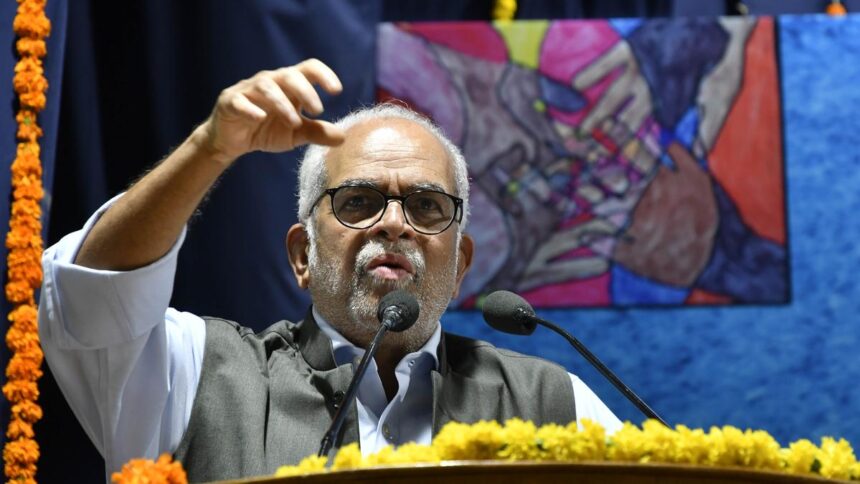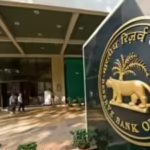The Nomination of Sudershan Reddy – A Turning Point in Indian Politics
The announcement of former Supreme Court Judge Sudershan Reddy as the Opposition’s candidate for the Vice President elections has set the stage for one of the most closely watched political contests in recent years. The move reflects a deliberate and strategic choice by the Opposition bloc, which has been seeking to project unity while simultaneously challenging the ruling establishment.
Sudershan Reddy’s name carries significant weight in both judicial and political circles. As a retired Supreme Court judge, his career has been marked by landmark judgments, an unshakable reputation for integrity, and a firm belief in constitutional values. By putting forward a candidate of such stature, the Opposition appears to be sending a clear signal — that this election is not just about numbers in Parliament, but also about the larger moral narrative of governance, justice, and democratic accountability.
Historically, the Vice President of India has been a position that often receives less public attention compared to the office of the President or the Prime Minister. Yet, the Vice President plays a pivotal role in the functioning of the Indian democracy, particularly as the Chairman of the Rajya Sabha, where crucial debates, policy discussions, and legislative confrontations unfold. The choice of candidate, therefore, is never a mere formality. It is a reflection of the political climate, the balance of power, and the ideological battles shaping the nation’s future.
For the Opposition, fielding Sudershan Reddy offers several advantages. First, it allows them to bridge the gap between politics and constitutional morality. In an environment where the judiciary and executive are often perceived to be at odds, nominating a former judge projects credibility and independence. Second, his candidature may help the bloc rally wider support, particularly among fence-sitters, independents, and smaller regional parties that respect his stature but may not align completely with either camp.
On the other side, the ruling coalition is expected to put forward a candidate with equal political heft, ensuring that the contest is anything but symbolic. However, what sets this election apart is not just the names on the ballot but the narratives attached to them. Sudershan Reddy’s nomination brings constitutional ideals to the forefront, raising questions about the kind of leadership that India requires in its legislative institutions.
The announcement has already stirred intense debates within the corridors of power, media studios, and public forums. Is this a genuine attempt by the Opposition to elevate the quality of politics, or is it a carefully crafted political gamble aimed at unsettling the ruling camp? Whatever the answer, the fact remains that this election promises to be a defining moment — one that goes beyond numbers and delves deep into India’s democratic ethos.
The nomination of Justice Sudershan Reddy cannot be understood merely as a political act — it is also the culmination of a long journey defined by his values, education, and contribution to Indian jurisprudence. To grasp the significance of his candidature, it is important to revisit the milestones of his life and career, which shaped the reputation he carries into the electoral arena today.
A Life Rooted in Humble Beginnings
Sudershan Reddy’s story begins in Andhra Pradesh, where he was born into a family that valued both education and service to society. His upbringing was deeply rooted in the traditions of discipline, hard work, and respect for justice — qualities that would later define his professional path. From his early school days, Reddy displayed a sharp intellect and a keen sense of fairness. Teachers and peers often recalled him as someone who questioned authority not for the sake of defiance, but out of a genuine pursuit of truth.
This natural inclination toward justice made law an almost inevitable choice for him. After completing his education in law, he quickly emerged as a promising lawyer, gaining respect not just for his legal acumen but also for his ability to engage with clients and communities at a human level. Unlike many who saw the profession as merely a career, Reddy approached it as a duty — to protect the rights of individuals and uphold the Constitution.
Rise Through the Judiciary
Reddy’s rise within the Indian judiciary was marked by dedication and a spotless track record. He was appointed as a judge of the Andhra Pradesh High Court, where he presided over cases that dealt with sensitive socio-economic issues, constitutional questions, and matters of public importance. His judgments often reflected a blend of legal precision and social conscience.
In due course, his reputation led to his elevation as a judge of the Supreme Court of India. At the apex court, Justice Reddy cemented his position as one of the most respected judicial minds of his time. His work often reflected a balance between strict constitutional interpretation and progressive human values. Colleagues admired his meticulous preparation for cases, while litigants and lawyers respected his fairness and independence.
Hallmark Judgments and Contributions
Throughout his career, Justice Reddy was involved in several landmark rulings that shaped Indian law. While not every judgment bore his name in bold headlines, his contributions were vital in shaping debates around federalism, rights of citizens, social justice, and accountability of public institutions.
One of the recurring themes in his judicial philosophy was the belief that the Constitution is not just a legal document but a living guide for governance and justice. He emphasized that the judiciary’s role was not to encroach upon the domain of the legislature or executive, but to act as a safeguard whenever constitutional morality was threatened.
Justice Reddy was also known for his sharp observations in court. On multiple occasions, he reminded both the state and private actors of their responsibility toward ordinary citizens, particularly the marginalized. His words often echoed the idea that democracy cannot survive merely on elections, but thrives only when citizens are empowered and justice is accessible.
Judicial Philosophy: Integrity, Independence, and Social Justice
The hallmark of Justice Reddy’s judicial philosophy was his commitment to integrity and independence. He firmly believed that the judiciary must remain free from political or corporate pressures, for only then could it deliver impartial justice. This principle guided his conduct both inside and outside the courtroom.
Equally important was his focus on social justice. For him, the Constitution was not just about abstract legal principles; it was about ensuring dignity, equality, and opportunities for every citizen. His judgments reflected empathy toward the underprivileged, ensuring that the law was not just a shield for the powerful but also a tool of empowerment for the weak.
Transition to Public Life
After his retirement, Justice Reddy largely stayed away from partisan politics, which makes his nomination today even more significant. Unlike career politicians, he carried into public life an image of neutrality, balance, and deep respect for constitutional processes. His occasional public speeches and writings reflected concern over the erosion of democratic institutions, the need for checks and balances, and the importance of judicial independence.
It is precisely this reputation — that of a statesman-like figure untainted by partisan loyalties — that makes his candidacy for Vice President so compelling. The Opposition’s choice of Sudershan Reddy is, therefore, not only about contesting an election but about redefining the values of the office itself.
When the Opposition announced Justice (Retd.) Sudershan Reddy as its candidate for the Vice President elections, the move immediately stirred debates across India’s political spectrum. It wasn’t just a matter of fielding a strong candidate; it was a calculated political strategy intended to send multiple messages to voters, parties, and institutions.
A Move Rooted in Symbolism
The Vice President’s election often carries less drama compared to that of the President. Yet, in recent years, the role has acquired new importance — not merely because the Vice President serves as the Chairperson of the Rajya Sabha, but also because the individual embodies the democratic spirit of impartiality. By nominating Justice Reddy, the Opposition made a symbolic statement: that they want the second-highest constitutional office in the country to be held by someone above party lines, grounded in judicial independence, and respected across communities.
This symbolism matters deeply in today’s political climate, where the independence of institutions has become a heated subject of national conversation. With Reddy’s nomination, the Opposition is clearly pitching itself as the custodian of constitutional morality.
Broadening the Opposition’s Appeal
The Opposition’s choice was also aimed at broadening its political and social appeal. Unlike a candidate tied to one region, caste, or ideology, Justice Reddy is perceived as a neutral figure. His South Indian roots strengthen the Opposition’s presence in southern states like Andhra Pradesh, Telangana, Tamil Nadu, and Kerala, where regional pride plays a crucial role in elections.
Furthermore, as a retired Supreme Court judge, his credibility resonates not just with the legal community but also with citizens who value fairness and justice. By nominating him, the Opposition hopes to appeal to urban voters, educated middle classes, and young citizens who often look for integrity over rhetoric.
Countering the Ruling Party’s Narrative
The ruling party often enters Vice Presidential elections with the advantage of numbers, particularly given its strength in the Lok Sabha and its alliances. By fielding Justice Reddy, the Opposition cannot simply hope to match numbers — instead, it aims to counter the ruling party’s narrative by presenting a candidate who embodies values of independence, non-partisanship, and inclusivity.
Even if victory remains uncertain in numerical terms, the Opposition’s strategy is to frame the contest as a battle of ideas: should the Vice President be a political functionary, or should the office remain above the fray of everyday politics? In this sense, Justice Reddy becomes not just a candidate but a symbolic rallying point for those who believe that institutions must remain insulated from partisan control.
Uniting a Fragmented Opposition
Another major political calculation lies in the ability of this nomination to unite disparate Opposition parties. Historically, Opposition unity has been fragile, often breaking down over candidate selection. By nominating a retired judge with no overt political baggage, the Opposition has created a figure around whom different parties can rally without fear of ideological compromise.
For regional parties wary of supporting leaders from rival states or communities, Justice Reddy’s candidature offers neutrality. His judicial background also assures parties that the contest is not about promoting a future political leader but about protecting constitutional principles.
The Rajya Sabha Factor
The Vice President of India also serves as the Chairperson of the Rajya Sabha, which has increasingly become the battleground of major legislative debates. The Opposition knows that control over Rajya Sabha proceedings carries significant weight in the larger scheme of Indian democracy.
Justice Reddy’s experience as a Supreme Court judge positions him as someone capable of ensuring fairness, discipline, and adherence to constitutional rules within the Upper House. His reputation for impartiality and command over constitutional law makes him a credible candidate to preside over heated parliamentary debates, thereby restoring dignity and order in an institution often marked by disruptions.
Sending a Signal to the Judiciary and Civil Society
The choice of a former Supreme Court judge also carries a subtle yet powerful message to the judiciary and civil society. In recent years, concerns have been raised about judicial independence and the pressures of political influence. By nominating Justice Reddy, the Opposition is not only seeking votes but also sending a message of reassurance to judges, lawyers, activists, and ordinary citizens that it remains committed to the autonomy of institutions.
It also speaks to civil society groups who have long demanded that constitutional offices be occupied by individuals of stature and credibility rather than career politicians. Justice Reddy represents precisely that — a bridge between the world of law and the world of governance.
Challenges Facing the Opposition’s Strategy
Of course, the Opposition’s strategy is not without challenges. The ruling party’s numerical advantage in Parliament means that Justice Reddy’s path to victory remains steep. Critics argue that the nomination, while symbolically powerful, may ultimately be reduced to a moral victory rather than an actual one.
Yet, even in potential defeat, the Opposition sees an opportunity. By framing the contest around constitutional values and judicial independence, it hopes to shift the narrative in its favor, energize its base, and highlight the ruling party’s lack of commitment to institutional autonomy.
A Contest Beyond Numbers
In the final analysis, the Opposition’s nomination of Justice Sudershan Reddy is not just about winning an election but about shaping political discourse. It is an attempt to redefine what the Vice President’s office should stand for in the 21st century — impartiality, fairness, and respect for the Constitution.
Whether or not Justice Reddy secures victory, his candidature ensures that the election becomes a platform for debate on democracy, institutional independence, and the role of non-partisan leadership.
The announcement of Justice Sudershan Reddy as the Opposition’s nominee for Vice President of India did not remain confined to political corridors. The decision quickly spilled into the public domain, sparking reactions from citizens, intellectuals, media outlets, and even the legal fraternity. While some hailed it as a bold, visionary move, others dismissed it as symbolic politics with little chance of altering the electoral outcome.
Public Sentiment: A Mixture of Surprise and Approval
For the ordinary citizen, the nomination of a former Supreme Court judge for a high political office was both unexpected and refreshing. Traditionally, Vice Presidential candidates have been drawn from the ranks of seasoned politicians. The choice of a jurist, therefore, represented a break from tradition.
Among many urban and educated voters, particularly those active on social media platforms, the move was welcomed as a step towards depoliticizing constitutional posts. Hashtags like #JusticeForVP and #ReddyForVP trended briefly, reflecting enthusiasm among certain sections.
At the same time, there was a measure of skepticism. Some voters questioned whether such symbolic moves could truly influence governance, particularly when the numerical strength in Parliament clearly favors the ruling party. For them, the nomination appeared less about winning and more about political posturing.
Reactions from the Legal Fraternity
The legal community’s response carried special weight, given Justice Reddy’s long career in the judiciary. Many senior advocates, law professors, and former judges described the move as a “sign of respect for judicial integrity.”
- Supportive Voices: Several legal experts highlighted Justice Reddy’s judgments during his tenure in the Supreme Court, particularly those touching on constitutional morality, civil liberties, and accountability of institutions. They argued that his candidature was more than symbolic — it reflected a call for restoring balance between politics and the Constitution.
- Critical Voices: On the other hand, some legal analysts expressed concern about the growing overlap between judiciary and politics. They warned that the entry of judges into political contests, even after retirement, could reinforce suspicions that judicial independence is vulnerable to political interests. This argument sparked a broader debate: should retired judges accept political nominations at all, or does it dilute the credibility of their past judicial work?
The Ruling Party’s Counter-Strategy
The ruling party was quick to counter the Opposition’s narrative. Its leaders argued that the Vice President’s office should not be turned into an arena for political symbolism. They emphasized that the election should reflect democratic numbers, not rhetorical gestures.
Senior figures from the ruling coalition subtly questioned whether the Opposition was “using” the credibility of the judiciary to make up for its own lack of unity and strength. Others framed the nomination as an act of desperation — a way to seek moral ground when electoral victory appears nearly impossible.
At the same time, the ruling party projected its own candidate as a leader with proven political experience, administrative capability, and loyalty to governance priorities. This created a contrast between experience and symbolism — a narrative the ruling coalition hoped would resonate with its supporters.
Media Coverage: Between Symbolism and Realpolitik
The media landscape responded with the usual diversity of tone.
- Mainstream Media: Prominent newspapers and TV channels framed the story in terms of symbolism versus numbers. Editorials praised the intellectual weight of nominating a retired Supreme Court judge, but they also pointed out the harsh arithmetic of Parliament that favors the ruling party.
- Regional Media: Outlets in Telangana and Andhra Pradesh highlighted the nomination as a moment of pride for the region, emphasizing Justice Reddy’s roots and contribution to Indian jurisprudence.
- Digital Media and Opinion Portals: Online platforms were more experimental in their takes, with some describing the move as a “masterstroke of moral politics” while others critiqued it as a “wasted opportunity” given the Opposition’s fragile numbers.
The debate also extended into TV panel discussions, where constitutional experts sparred with political analysts over the long-term impact of such nominations on democratic institutions.
Civil Society and Academia
Civil society organizations, particularly those engaged in judicial accountability and democratic rights, largely welcomed the Opposition’s choice. They argued that the Vice President’s office should not be reduced to a party reward system, and Justice Reddy’s candidacy symbolized the kind of institutional integrity India needs.
Within academic circles, the nomination sparked fresh discussions about the boundaries between judiciary and politics. Law students, researchers, and university professors debated whether such crossovers strengthened or weakened democracy. For some, Justice Reddy’s candidature was a reminder of the fluid relationship between law and governance, while for others it represented a blurring of lines best kept separate.
Symbolism vs. Reality
At the core of these responses lies a tension: the nomination of Justice Reddy is undeniably symbolic, but symbols matter in politics. They shape narratives, shift public opinion, and frame future debates.
While the ruling party continues to rely on its numerical superiority, the Opposition’s decision ensures that the Vice Presidential election does not remain a mere formality. Instead, it becomes a referendum on what citizens expect from constitutional offices — loyalty to party or loyalty to principle.
Also Read : AIBOC Warns Against Unilateral Roll-Out of RBI’s AI Framework Without Dialogue & Safeguards








